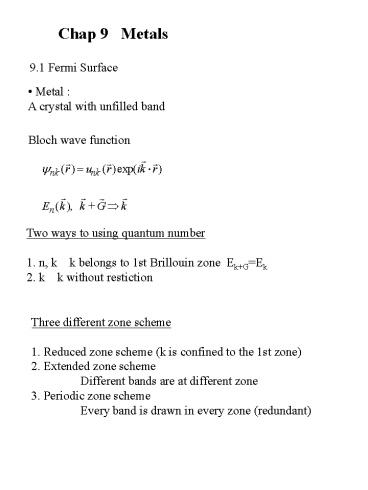Chap 9 Metals PowerPoint PPT Presentation
1 / 17
Title: Chap 9 Metals
1
Chap 9 Metals
9.1 Fermi Surface
- Metal
- A crystal with unfilled band
Bloch wave function
Two ways to using quantum number 1. n, k k
belongs to 1st Brillouin zone EkGEk 2. k k
without restiction
Three different zone scheme 1. Reduced zone
scheme (k is confined to the 1st zone) 2.
Extended zone scheme Different bands are at
different zone 3. Periodic zone scheme Every
band is drawn in every zone (redundant)
2
Reduced zone
3
2
1
-G/2
G/2
Extended zone
Repeated zone
3
- Description of energy in k-space
- In 2,3 dimensions, it is impossible to draw
energy vs k - curve directly. Instead it is customary to draw
- 1. Constant energy surface in k-space
- 2. Draw energy vs k in a particular direction
- Fermi surface
- The surface of the constant energy at EF in
k-space - Determine electrical properties of the metal
Free electron Sphere of radius kF kF (3p2
N/ V)1/3
Example Square Lattice in 2-dimensions
3rd zone
2nd zone
1st zone
4
Case 1)
Fermi surface
Within the 1st zone
Case ii)
3-rd zone
1-st zone
2-nd zone
5
- Effect of the lattice potential on the Fermi
Surface - 1. Develop energy gap at the zone boundary
- 2. Round out sharp corners in the Fermi surface
- 3. Total volume enclosed by the Fermi surface
- remained unchanged. (Determined by N/V)
- 4. The Fermi surface intersect the zone boundary
- perpendicularly
- Electron Orbit, hole Orbit, Open orbit
Electron orbit orbit that encloses filled state
Hole orbit orbit that encloses empty state
Open orbit
6
9.2 Alkali Metals
Group I Elements -Singly charged ions (Ion cores
have tightly bound rare gas configurations)
Li 1S2, 2S1 Na Ne 3S1 K Ar 4S1 Rb
Kr 5S1 Cs Xe 6S1
B.C.C. Structure
- Each atom gives up single electron - Best fit
to the Free electron theory
Fermi surface spherical
7
(No Transcript)
8
Shortest distant from origin to the 1st Brillouin
zone
B.C.C. --gt F.C.C (reciprocal lattice) (110)
direction
GN
4p/a
Fermi sphere is entirely contained within the
first zone, partially filled Band. Fermi surface
is very much spherical Free electron theory
E
hn
G
N
9
9.3 Noble Metals
-singly charged ions -Cu Ar 3d10 4s1 -Ag
Kr 4d10 5s1 -Au Xe 5d10 6s1
FCC structure
Ex) Cu 11electrons in the outer shell - Six
bands is required to describe 11 electrons 5
d-band 1 s-band
Noble metal is similar to Alkali metals except
that there are nearby d-orbitals. D-bands
narrow in energy
10
FCC structure --gt BCC reciprocal lattice lt111gt
direction is the closest Fermi surface necks
out the closest face
- Transport properties similar to the Alkali
metal - Optical properties d-band plays an important
- role. Excitation from d-band to the unoccupied
- conduction s-band.
11
(No Transcript)
12
9.4 Transition metals
The element between the Alkali Noble metals Mn,
Fe, Co, Ni Crystal structure FCC or BCC
- D-bands Not only lie high up in the conduction
band, - but also extends through the Fermi energy.
- Partially filled d-band magnetic properties
- Localized electrons
- tight binding models
d-band narrow energy range --gt high density of
state at Fermi energy (electronic heat capacity)
13
9.5 Tight binding models Start from atomic
levels of neutral atoms -gt as the atoms come
together, outer electronic levels starts to
overlap and form hybrid orbitals
Ex Two hydrogen atoms
yB
yA
A
B
HHAHB
Eigenvalue EA EB
When they are brought together to form a
molecules, their wavefunctions overlap and we
have the hamiltonian
14
The wave function
When there are N atoms in a crystal lattice, we
assume that the Bloch eigenfunction can be
written as a linear combination of atomic
orbitals (LACO), similar to the bonding case
15
Then the energy eigenvalue can be calculated by
For a simple cubic
16
Note 1) This approximation is good for
tightly-bound localized electrons (e.g. d-level,
f-level) Not good for free-electron-like
states 2) f(r) is called Wannier function
9.6 Rare Earth Metals
Partially filled 4f shells HCP structure Xe
4fn 5d1-0 6s2
Partially filled 4f shells do not play as
significant role as 3d, 4d, 5d levels in the
transition metals
17
Home work
1. A two-dimensional metal has one atom of
valency one in a simple rectangular primitive
cell, a2Å b4Å (a) Draw the first Brillouin
zone. Give its dimensions, in cm-1. (b) Calculate
the radius of the free electron Fermi sphere in
cm-1. (c) Draw this sphere to scale on a drawing
of the first Brillouin zone. Make another sketch
to show the first few periods of the free
electron band in the periodic zone scheme, for
both the first and second energy bands. Assume
there is a small energy gap at the zone
boundary. 2. Verify that in a crystal with an
fcc monoatomic Bravais lattice, the free electron
Fermi spherefor valence 1 reaches
(16/3p2)1/60.903 of the way from the origin to
the zone face, in the 111 direction.

